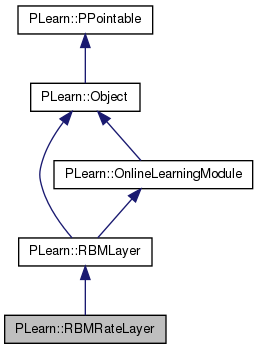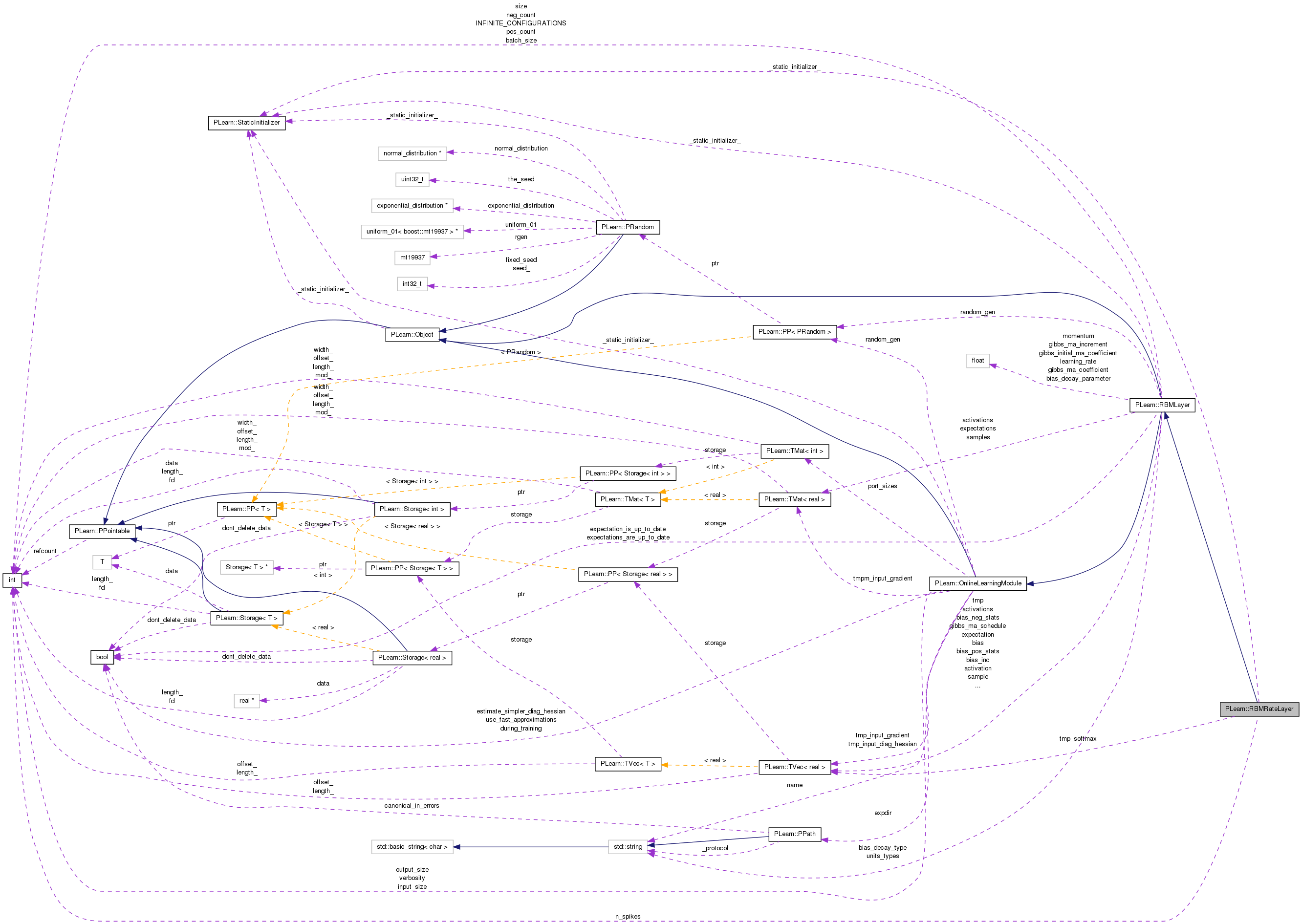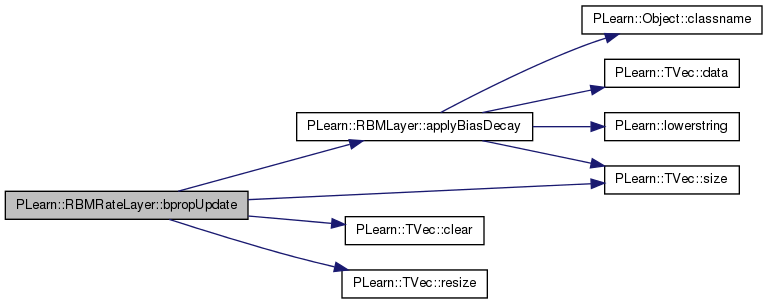|
PLearn 0.1
|
|
PLearn 0.1
|
Layer in an RBM consisting in rate-coded units. More...
#include <RBMRateLayer.h>


Public Member Functions | |
| RBMRateLayer (real the_learning_rate=0.) | |
| Default constructor. | |
| virtual void | generateSample () |
| generate a sample, and update the sample field | |
| virtual void | generateSamples () |
| batch version | |
| virtual void | computeExpectation () |
| compute the expectation | |
| virtual void | computeExpectations () |
| batch version | |
| virtual void | fprop (const Vec &input, Vec &output) const |
| forward propagation | |
| virtual void | bpropUpdate (const Vec &input, const Vec &output, Vec &input_gradient, const Vec &output_gradient, bool accumulate=false) |
| back-propagates the output gradient to the input | |
| virtual void | bpropUpdate (const Mat &inputs, const Mat &outputs, Mat &input_gradients, const Mat &output_gradients, bool accumulate=false) |
| back-propagates the output gradient to the input, in mini-batch mode | |
| virtual real | fpropNLL (const Vec &target) |
| Computes the negative log-likelihood of target given the internal activations of the layer. | |
| virtual void | bpropNLL (const Vec &target, real nll, Vec &bias_gradient) |
| Computes the gradient of the negative log-likelihood of target with respect to the layer's bias, given the internal activations. | |
| virtual real | energy (const Vec &unit_values) const |
| virtual real | freeEnergyContribution (const Vec &unit_activations) const |
Computes  This quantity is used for computing the free energy of a sample x in the OTHER layer of an RBM, from which unit_activations was computed. This quantity is used for computing the free energy of a sample x in the OTHER layer of an RBM, from which unit_activations was computed. | |
| virtual void | freeEnergyContributionGradient (const Vec &unit_activations, Vec &unit_activations_gradient, real output_gradient=1, bool accumulate=false) const |
Computes gradient of the result of freeEnergyContribution  with respect to unit_activations. with respect to unit_activations. | |
| virtual int | getConfigurationCount () |
| Returns a number of different configurations the layer can be in. | |
| virtual void | getConfiguration (int conf_index, Vec &output) |
| Computes the conf_index configuration of the layer. | |
| virtual string | classname () const |
| virtual OptionList & | getOptionList () const |
| virtual OptionMap & | getOptionMap () const |
| virtual RemoteMethodMap & | getRemoteMethodMap () const |
| virtual RBMRateLayer * | deepCopy (CopiesMap &copies) const |
| virtual void | build () |
| Post-constructor. | |
| virtual void | makeDeepCopyFromShallowCopy (CopiesMap &copies) |
| Transforms a shallow copy into a deep copy. | |
Static Public Member Functions | |
| static string | _classname_ () |
| static OptionList & | _getOptionList_ () |
| static RemoteMethodMap & | _getRemoteMethodMap_ () |
| static Object * | _new_instance_for_typemap_ () |
| static bool | _isa_ (const Object *o) |
| static void | _static_initialize_ () |
| static const PPath & | declaringFile () |
Public Attributes | |
| int | n_spikes |
| Maximum number of spikes for each neuron. | |
Static Public Attributes | |
| static StaticInitializer | _static_initializer_ |
Static Protected Member Functions | |
| static void | declareOptions (OptionList &ol) |
| Declares the class options. | |
Protected Attributes | |
| Vec | tmp_softmax |
Private Types | |
| typedef RBMLayer | inherited |
Private Member Functions | |
| void | build_ () |
| This does the actual building. | |
Layer in an RBM consisting in rate-coded units.
Definition at line 51 of file RBMRateLayer.h.
typedef RBMLayer PLearn::RBMRateLayer::inherited [private] |
Reimplemented from PLearn::RBMLayer.
Definition at line 53 of file RBMRateLayer.h.
| PLearn::RBMRateLayer::RBMRateLayer | ( | real | the_learning_rate = 0. | ) |
Default constructor.
Definition at line 53 of file RBMRateLayer.cc.
| string PLearn::RBMRateLayer::_classname_ | ( | ) | [static] |
Reimplemented from PLearn::RBMLayer.
Definition at line 51 of file RBMRateLayer.cc.
| OptionList & PLearn::RBMRateLayer::_getOptionList_ | ( | ) | [static] |
Reimplemented from PLearn::RBMLayer.
Definition at line 51 of file RBMRateLayer.cc.
| RemoteMethodMap & PLearn::RBMRateLayer::_getRemoteMethodMap_ | ( | ) | [static] |
Reimplemented from PLearn::RBMLayer.
Definition at line 51 of file RBMRateLayer.cc.
Reimplemented from PLearn::RBMLayer.
Definition at line 51 of file RBMRateLayer.cc.
| Object * PLearn::RBMRateLayer::_new_instance_for_typemap_ | ( | ) | [static] |
Reimplemented from PLearn::Object.
Definition at line 51 of file RBMRateLayer.cc.
| StaticInitializer RBMRateLayer::_static_initializer_ & PLearn::RBMRateLayer::_static_initialize_ | ( | ) | [static] |
Reimplemented from PLearn::RBMLayer.
Definition at line 51 of file RBMRateLayer.cc.
Computes the gradient of the negative log-likelihood of target with respect to the layer's bias, given the internal activations.
Reimplemented from PLearn::RBMLayer.
Definition at line 236 of file RBMRateLayer.cc.
References computeExpectation(), PLearn::RBMLayer::expectation, PLearn::OnlineLearningModule::input_size, PLASSERT, PLERROR, PLearn::TVec< T >::resize(), PLearn::TVec< T >::size(), PLearn::RBMLayer::size, and PLearn::substract().
{
PLERROR("In RBMRateLayer::bpropNLL(): not implemented");
computeExpectation();
PLASSERT( target.size() == input_size );
bias_gradient.resize( size );
// bias_gradient = expectation - target
substract(expectation, target, bias_gradient);
}

| void PLearn::RBMRateLayer::bpropUpdate | ( | const Vec & | input, |
| const Vec & | output, | ||
| Vec & | input_gradient, | ||
| const Vec & | output_gradient, | ||
| bool | accumulate = false |
||
| ) | [virtual] |
back-propagates the output gradient to the input
Implements PLearn::RBMLayer.
Definition at line 147 of file RBMRateLayer.cc.
References PLearn::RBMLayer::applyBiasDecay(), PLearn::RBMLayer::bias, PLearn::RBMLayer::bias_inc, PLearn::TVec< T >::clear(), i, PLearn::RBMLayer::learning_rate, PLearn::RBMLayer::momentum, n_spikes, PLASSERT, PLASSERT_MSG, PLearn::TVec< T >::resize(), PLearn::RBMLayer::size, and PLearn::TVec< T >::size().
{
PLASSERT( input.size() == size );
PLASSERT( output.size() == size );
PLASSERT( output_gradient.size() == size );
if( accumulate )
{
PLASSERT_MSG( input_gradient.size() == size,
"Cannot resize input_gradient AND accumulate into it" );
}
else
{
input_gradient.resize( size );
input_gradient.clear();
}
if( momentum != 0. )
bias_inc.resize( size );
for( int i=0 ; i<size ; i++ )
{
real output_i = output[i];
real in_grad_i;
in_grad_i = output_i * (1-output_i) * output_gradient[i] * n_spikes;
input_gradient[i] += in_grad_i;
if( momentum == 0. )
{
// update the bias: bias -= learning_rate * input_gradient
bias[i] -= learning_rate * in_grad_i;
}
else
{
// The update rule becomes:
// bias_inc = momentum * bias_inc - learning_rate * input_gradient
// bias += bias_inc
bias_inc[i] = momentum * bias_inc[i] - learning_rate * in_grad_i;
bias[i] += bias_inc[i];
}
}
applyBiasDecay();
}

| void PLearn::RBMRateLayer::bpropUpdate | ( | const Mat & | inputs, |
| const Mat & | outputs, | ||
| Mat & | input_gradients, | ||
| const Mat & | output_gradients, | ||
| bool | accumulate = false |
||
| ) | [virtual] |
back-propagates the output gradient to the input, in mini-batch mode
Implements PLearn::RBMLayer.
Definition at line 194 of file RBMRateLayer.cc.
References PLERROR.
{
PLERROR("In RBMRateLayer::bpropUpdate(): mini-batch version of bpropUpdate is not "
"implemented yet");
}
| void PLearn::RBMRateLayer::build | ( | ) | [virtual] |
Post-constructor.
The normal implementation should call simply inherited::build(), then this class's build_(). This method should be callable again at later times, after modifying some option fields to change the "architecture" of the object.
Reimplemented from PLearn::RBMLayer.
Definition at line 266 of file RBMRateLayer.cc.
References PLearn::RBMLayer::build(), and build_().
{
inherited::build();
build_();
}

| void PLearn::RBMRateLayer::build_ | ( | ) | [private] |
This does the actual building.
Reimplemented from PLearn::RBMLayer.
Definition at line 260 of file RBMRateLayer.cc.
References n_spikes, and PLERROR.
Referenced by build().

| string PLearn::RBMRateLayer::classname | ( | ) | const [virtual] |
Reimplemented from PLearn::Object.
Definition at line 51 of file RBMRateLayer.cc.
| void PLearn::RBMRateLayer::computeExpectation | ( | ) | [virtual] |
compute the expectation
Implements PLearn::RBMLayer.
Definition at line 98 of file RBMRateLayer.cc.
References PLearn::RBMLayer::activation, PLearn::RBMLayer::expectation, PLearn::RBMLayer::expectation_is_up_to_date, PLearn::fastsigmoid(), i, n_spikes, PLearn::sigmoid(), PLearn::RBMLayer::size, and PLearn::OnlineLearningModule::use_fast_approximations.
Referenced by bpropNLL().
{
if( expectation_is_up_to_date )
return;
if (use_fast_approximations)
for(int i=0; i<size; i++)
expectation[i] = n_spikes*fastsigmoid(activation[i]);
else
for(int i=0; i<size; i++)
expectation[i] = n_spikes*sigmoid(activation[i]);
expectation_is_up_to_date = true;
}


| void PLearn::RBMRateLayer::computeExpectations | ( | ) | [virtual] |
batch version
Implements PLearn::RBMLayer.
Definition at line 112 of file RBMRateLayer.cc.
References PLearn::RBMLayer::activations, PLearn::RBMLayer::batch_size, PLearn::RBMLayer::expectations, PLearn::RBMLayer::expectations_are_up_to_date, PLearn::fastsigmoid(), i, PLearn::TMat< T >::length(), n_spikes, PLASSERT, PLearn::sigmoid(), PLearn::RBMLayer::size, PLearn::OnlineLearningModule::use_fast_approximations, and PLearn::TMat< T >::width().
{
if( expectations_are_up_to_date )
return;
PLASSERT( expectations.width() == size
&& expectations.length() == batch_size );
if (use_fast_approximations)
for (int k = 0; k < batch_size; k++)
for(int i=0; i<size; i++)
expectations(k,i) = n_spikes*fastsigmoid(activations(k,i));
else
for (int k = 0; k < batch_size; k++)
for(int i=0; i<size; i++)
expectations(k,i) = n_spikes*sigmoid(activations(k,i));
expectations_are_up_to_date = true;
}

| void PLearn::RBMRateLayer::declareOptions | ( | OptionList & | ol | ) | [static, protected] |
Declares the class options.
Reimplemented from PLearn::RBMLayer.
Definition at line 249 of file RBMRateLayer.cc.
References PLearn::OptionBase::buildoption, PLearn::declareOption(), PLearn::RBMLayer::declareOptions(), and n_spikes.
{
declareOption(ol, "n_spikes", &RBMRateLayer::n_spikes,
OptionBase::buildoption,
"Maximum number of spikes for each neuron.\n");
// Now call the parent class' declareOptions
inherited::declareOptions(ol);
}

| static const PPath& PLearn::RBMRateLayer::declaringFile | ( | ) | [inline, static] |
Reimplemented from PLearn::RBMLayer.
Definition at line 127 of file RBMRateLayer.h.
:
//##### Not Options #####################################################
| RBMRateLayer * PLearn::RBMRateLayer::deepCopy | ( | CopiesMap & | copies | ) | const [virtual] |
Reimplemented from PLearn::RBMLayer.
Definition at line 51 of file RBMRateLayer.cc.
Reimplemented from PLearn::RBMLayer.
Definition at line 279 of file RBMRateLayer.cc.
References PLearn::RBMLayer::bias, and PLearn::dot().

forward propagation
Reimplemented from PLearn::RBMLayer.
Definition at line 132 of file RBMRateLayer.cc.
References PLearn::RBMLayer::bias, PLearn::fastsigmoid(), i, PLearn::OnlineLearningModule::input_size, n_spikes, PLearn::OnlineLearningModule::output_size, PLASSERT, PLearn::TVec< T >::resize(), PLearn::sigmoid(), PLearn::RBMLayer::size, PLearn::TVec< T >::size(), and PLearn::OnlineLearningModule::use_fast_approximations.
{
PLASSERT( input.size() == input_size );
output.resize( output_size );
if (use_fast_approximations)
for(int i=0; i<size; i++)
output[i] = n_spikes*fastsigmoid(input[i]+bias[i]);
else
for(int i=0; i<size; i++)
output[i] = n_spikes*sigmoid(input[i]+bias[i]);
}

Computes the negative log-likelihood of target given the internal activations of the layer.
Reimplemented from PLearn::RBMLayer.
Definition at line 206 of file RBMRateLayer.cc.
References PLearn::RBMLayer::activation, i, PLearn::OnlineLearningModule::input_size, PLASSERT, PLERROR, PLearn::TVec< T >::size(), PLearn::RBMLayer::size, PLearn::softplus(), PLearn::tabulated_softplus(), and PLearn::OnlineLearningModule::use_fast_approximations.
{
PLERROR("In RBMRateLayer::fpropNLL(): not implemented");
PLASSERT( target.size() == input_size );
real ret = 0;
real target_i, activation_i;
if(use_fast_approximations){
for( int i=0 ; i<size ; i++ )
{
target_i = target[i];
activation_i = activation[i];
ret += tabulated_softplus(activation_i) - target_i * activation_i;
// nll = - target*log(sigmoid(act)) -(1-target)*log(1-sigmoid(act))
// but it is numerically unstable, so use instead the following identity:
// = target*softplus(-act) +(1-target)*(act+softplus(-act))
// = act + softplus(-act) - target*act
// = softplus(act) - target*act
}
} else {
for( int i=0 ; i<size ; i++ )
{
target_i = target[i];
activation_i = activation[i];
ret += softplus(activation_i) - target_i * activation_i;
}
}
return ret;
}

Computes  This quantity is used for computing the free energy of a sample x in the OTHER layer of an RBM, from which unit_activations was computed.
This quantity is used for computing the free energy of a sample x in the OTHER layer of an RBM, from which unit_activations was computed.
Reimplemented from PLearn::RBMLayer.
Definition at line 284 of file RBMRateLayer.cc.
References a, PLearn::TVec< T >::data(), i, n_spikes, PLASSERT, PLearn::TVec< T >::size(), PLearn::RBMLayer::size, PLearn::softplus(), PLearn::tabulated_softplus(), and PLearn::OnlineLearningModule::use_fast_approximations.
{
PLASSERT( unit_activations.size() == size );
// result = -\sum_{i=0}^{size-1} softplus(a_i)
real result = 0;
real* a = unit_activations.data();
for (int i=0; i<size; i++)
{
if (use_fast_approximations)
result -= n_spikes*tabulated_softplus(a[i]);
else
result -= n_spikes*softplus(a[i]);
}
return result;
}

| void PLearn::RBMRateLayer::freeEnergyContributionGradient | ( | const Vec & | unit_activations, |
| Vec & | unit_activations_gradient, | ||
| real | output_gradient = 1, |
||
| bool | accumulate = false |
||
| ) | const [virtual] |
Computes gradient of the result of freeEnergyContribution  with respect to unit_activations.
with respect to unit_activations.
Optionally, a gradient with respect to freeEnergyContribution can be given
Reimplemented from PLearn::RBMLayer.
Definition at line 302 of file RBMRateLayer.cc.
References a, PLearn::TVec< T >::clear(), PLearn::TVec< T >::data(), PLearn::fastsigmoid(), i, n_spikes, PLASSERT, PLearn::TVec< T >::resize(), PLearn::sigmoid(), PLearn::TVec< T >::size(), PLearn::RBMLayer::size, and PLearn::OnlineLearningModule::use_fast_approximations.
{
PLASSERT( unit_activations.size() == size );
unit_activations_gradient.resize( size );
if( !accumulate ) unit_activations_gradient.clear();
real* a = unit_activations.data();
real* ga = unit_activations_gradient.data();
for (int i=0; i<size; i++)
{
if (use_fast_approximations)
ga[i] -= output_gradient * n_spikes *
fastsigmoid( a[i] );
else
ga[i] -= output_gradient * n_spikes *
sigmoid( a[i] );
}
}

| void PLearn::RBMRateLayer::generateSample | ( | ) | [virtual] |
generate a sample, and update the sample field
Implements PLearn::RBMLayer.
Definition at line 59 of file RBMRateLayer.cc.
References PLearn::RBMLayer::expectation, PLearn::RBMLayer::expectation_is_up_to_date, i, n_spikes, PLASSERT_MSG, PLCHECK_MSG, PLearn::RBMLayer::random_gen, PLearn::RBMLayer::sample, and PLearn::RBMLayer::size.
{
PLASSERT_MSG(random_gen,
"random_gen should be initialized before generating samples");
PLCHECK_MSG(expectation_is_up_to_date, "Expectation should be computed "
"before calling generateSample()");
real exp_i = 0;
for( int i=0; i<size; i++)
{
exp_i = expectation[i];
sample[i] = round(random_gen->gaussian_mu_sigma(
exp_i,exp_i*(1-exp_i/n_spikes)) );
}
}
| void PLearn::RBMRateLayer::generateSamples | ( | ) | [virtual] |
batch version
Implements PLearn::RBMLayer.
Definition at line 76 of file RBMRateLayer.cc.
References PLearn::RBMLayer::batch_size, PLearn::RBMLayer::expectations, PLearn::RBMLayer::expectations_are_up_to_date, i, PLearn::TMat< T >::length(), n_spikes, PLASSERT, PLASSERT_MSG, PLCHECK_MSG, PLearn::RBMLayer::random_gen, PLearn::RBMLayer::samples, PLearn::RBMLayer::size, and PLearn::TMat< T >::width().
{
PLASSERT_MSG(random_gen,
"random_gen should be initialized before generating samples");
PLCHECK_MSG(expectations_are_up_to_date, "Expectations should be computed "
"before calling generateSamples()");
PLASSERT( samples.width() == size && samples.length() == batch_size );
real exp_i = 0;
for (int k = 0; k < batch_size; k++)
{
for( int i=0; i<size; i++)
{
exp_i = expectations(k,i);
samples(k,i) = round(random_gen->gaussian_mu_sigma(
exp_i,exp_i*(1-exp_i/n_spikes)) );
}
}
}

Computes the conf_index configuration of the layer.
Reimplemented from PLearn::RBMLayer.
Definition at line 328 of file RBMRateLayer.cc.
References PLERROR.
{
PLERROR("In RBMRateLayer::getConfiguration(): not implemented");
}
| int PLearn::RBMRateLayer::getConfigurationCount | ( | ) | [virtual] |
Returns a number of different configurations the layer can be in.
Reimplemented from PLearn::RBMLayer.
Definition at line 323 of file RBMRateLayer.cc.
References PLearn::RBMLayer::INFINITE_CONFIGURATIONS.
{
return INFINITE_CONFIGURATIONS;
}
| OptionList & PLearn::RBMRateLayer::getOptionList | ( | ) | const [virtual] |
Reimplemented from PLearn::Object.
Definition at line 51 of file RBMRateLayer.cc.
| OptionMap & PLearn::RBMRateLayer::getOptionMap | ( | ) | const [virtual] |
Reimplemented from PLearn::Object.
Definition at line 51 of file RBMRateLayer.cc.
| RemoteMethodMap & PLearn::RBMRateLayer::getRemoteMethodMap | ( | ) | const [virtual] |
Reimplemented from PLearn::Object.
Definition at line 51 of file RBMRateLayer.cc.
| void PLearn::RBMRateLayer::makeDeepCopyFromShallowCopy | ( | CopiesMap & | copies | ) | [virtual] |
Transforms a shallow copy into a deep copy.
Reimplemented from PLearn::RBMLayer.
Definition at line 273 of file RBMRateLayer.cc.
References PLearn::RBMLayer::makeDeepCopyFromShallowCopy().
{
inherited::makeDeepCopyFromShallowCopy(copies);
//deepCopyField(tmp_softmax, copies);
}

Reimplemented from PLearn::RBMLayer.
Definition at line 127 of file RBMRateLayer.h.
Maximum number of spikes for each neuron.
Definition at line 59 of file RBMRateLayer.h.
Referenced by bpropUpdate(), build_(), computeExpectation(), computeExpectations(), declareOptions(), fprop(), freeEnergyContribution(), freeEnergyContributionGradient(), generateSample(), and generateSamples().
Vec PLearn::RBMRateLayer::tmp_softmax [mutable, protected] |
Definition at line 137 of file RBMRateLayer.h.
 1.7.4
1.7.4